How to grow asparagus
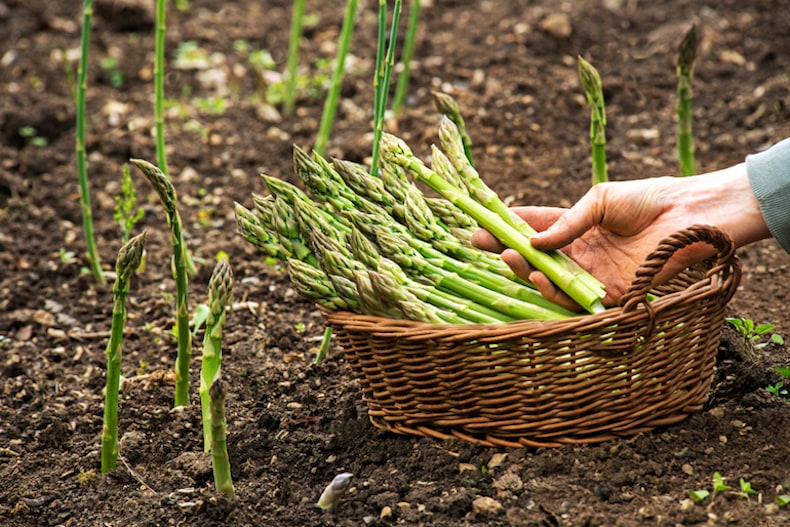
Grow your own asparagus - it's easy!
Image: Asparagus officinalis Guelph Millennium from Thompson & Morgan
Everyone loves asparagus. But its delicious flavour and short season often make this vegetable an expensive luxury. Of course, it doesn’t have to be this way. There’s no need to pay exorbitant store prices when you can grow your own.
And growing asparagus here in the UK is a fairly simple process. What’s more, once established, your asparagus beds will deliver delicious crops for up to 25 years!
Ready to start growing your own? Read our useful guide on how and when to grow asparagus plants from crowns.
Can you grow asparagus from seed?

It's easier to plant asparagus crowns rather than growing from seed
Image: Stephanie Frey/Shutterstock
You can grow asparagus from seed - but it’s much easier to plant bare-root crowns straight into the ground. Asparagus crowns are year-old dormant plants. Most varieties of asparagus are available as bare-root crowns.
Best time to plant asparagus
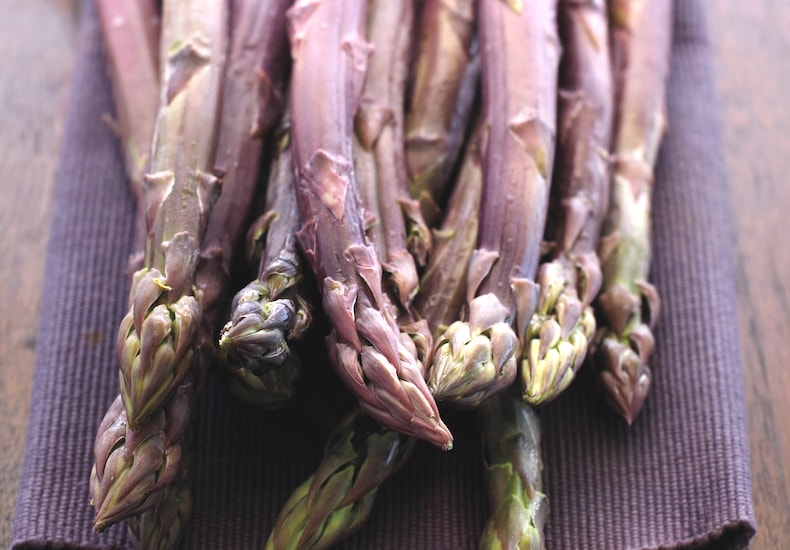
Asparagus 'Burgundine' can be planted in spring
Image: Asparagus 'Burgundine' (Spring Planting) from Thompson & Morgan
Traditionally, gardeners have always planted bare-root asparagus crowns in the spring. But you can also plant them in the autumn when the soil is warmer - this will give your plants a head start on establishing. You can order most varieties of asparagus for planting in spring or autumn - whichever you prefer.
How long does asparagus take to grow?
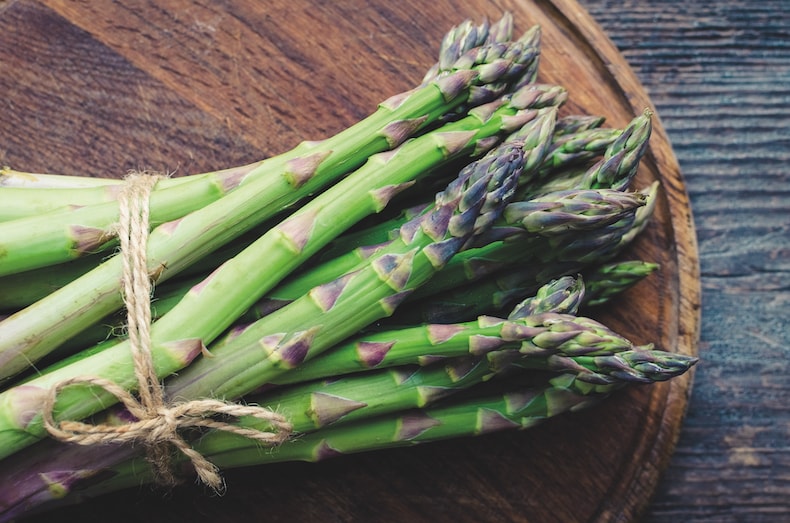
Asparagus takes a good few years to start producing harvestable spears
Image: Asparagus 'Backlim' from Thompson & Morgan
A single row of 10-12 plants will start to produce a decent crop after two years. You won’t be able to harvest your asparagus for the first two years after planting. But once it’s established, each asparagus crown can produce up to 25 spears per year and will continue cropping for 25 years!
Where to plant asparagus
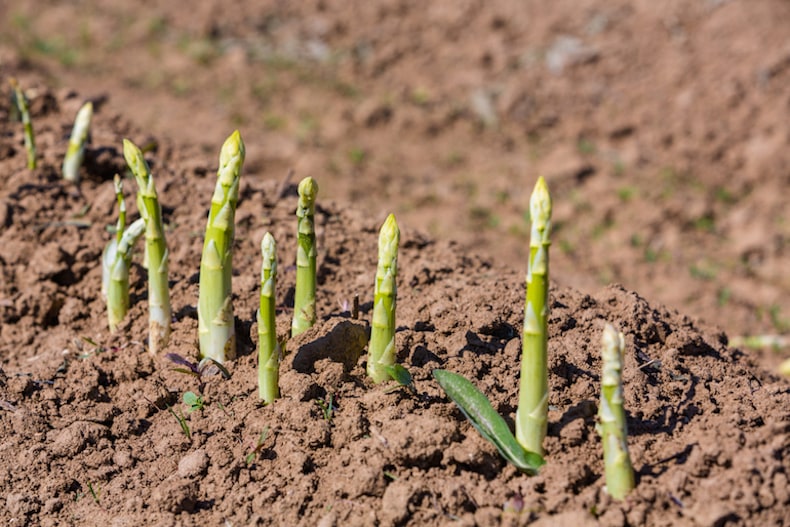
Choose a sunny, well-drained position for your asparagus beds
Image: Shutterstock
Asparagus needs a permanent home in your garden. Choose a sheltered, sunny position in fertile, well-drained soil. Don't worry if your soil isn’t perfect - you can dig in plenty of well-rotted manure or garden compost to improve soil structure and fertility.
If you’re gardening in cold, wet soil, adding sharp sand or grit will help improve drainage. Alternatively, you can grow asparagus in a raised bed - see below.
Asparagus likes a pH level of 6.5-7.5, so you might need to add lime to more acidic soils.
Lastly, don’t replant an old asparagus bed with new asparagus crowns - choosing fresh ground will prevent a build up of diseases.
How to prepare an asparagus bed
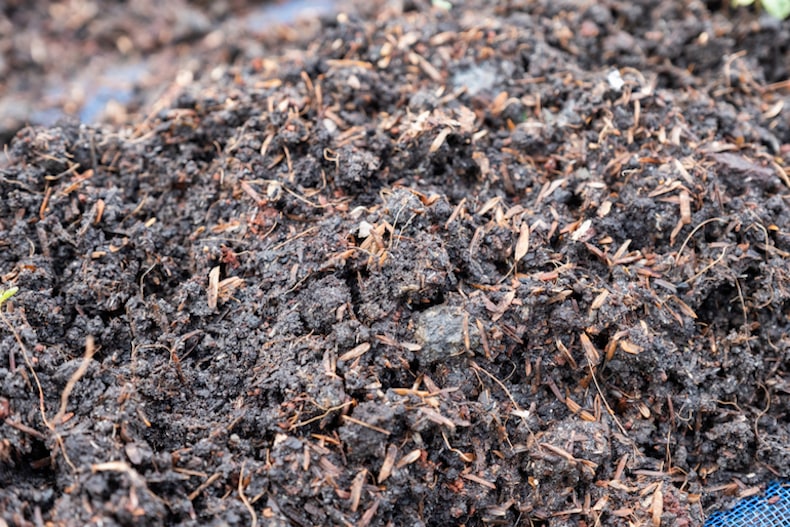
Mulch asparagus beds in late winter to deter weeds
Image: Mumemories/Shutterstock
Prepare your asparagus bed well in advance - asparagus crowns should be planted as soon as they’re delivered, so it’s well worth doing all the prep work first.
Select the ideal spot for your asparagus and make sure the ground is completely weed free. The shallow roots of asparagus crowns are easily damaged by a hoe, so it's really important to start with a weed-free asparagus bed before you plant.
Improve your soil by digging in one bucket load of organic matter, such as compost or well-rotted manure, per square metre.
And, if you’re really ahead of yourself, you can also mulch your asparagus bed in late winter with manure or compost to keep the ground moist and deter weeds. Cover the earth with an opaque weed mat over the winter to prevent weeds from germinating.
How to plant asparagus crowns
Plant your crowns as soon as possible after delivery. Because asparagus enjoys really good drainage, it’s best planted in trenches of around 20cm (10") deep by 30cm (12") wide. Fill the bottom of each trench with 7cm (3") of well-rotted manure or garden compost to help feed the plants in future years. Mound the excavated soil on top of the manure to form a ridge down the middle of each trench.
Place each asparagus crown on top of the ridge with their roots draped over the edges. Asparagus plants will need plenty of space in the coming years so lay them out at a distance of 45cm (18") apart. Cover the crowns with 7cm (3") of soil and then firm them into position before watering well and mulching with 5cm (2in) of well-rotted manure or other organic matter.
Watch our expert in-house gardener planting asparagus in this short video
How to grow asparagus in a raised bed?
If you prefer, you can grow asparagus in a raised bed. In a standard raised bed (1.2m or 4ft wide), you’ll want to dig a trench down the centre of the bed. Then follow the instructions for planting asparagus crowns above.
Dig in plenty of well-rotted manure or compost to the soil the winter before planting your asparagus. Add some horticultural grit as well, to help with drainage.
Caring for your asparagus crowns
To get the most from your asparagus plants, you’ll need to give them a little bit of attention. Here are some simple maintenance tasks to keep on top of throughout the year:
- Spring: Feed with a general fertiliser each March.
- Summer: Keep well watered during hot spells, to prevent them from drying out - asparagus plants have relatively shallow roots so this can happen quickly. The shallow roots can also be easily damaged by using a hoe, so weed by hand.
- Autumn: Cut back the yellowing foliage and mulch the crowns with well-rotted manure to protect them from frost and prevent weeds.
- Winter: Cover your beds with opaque weed matting to prevent weeds from germinating.
How to harvest asparagus
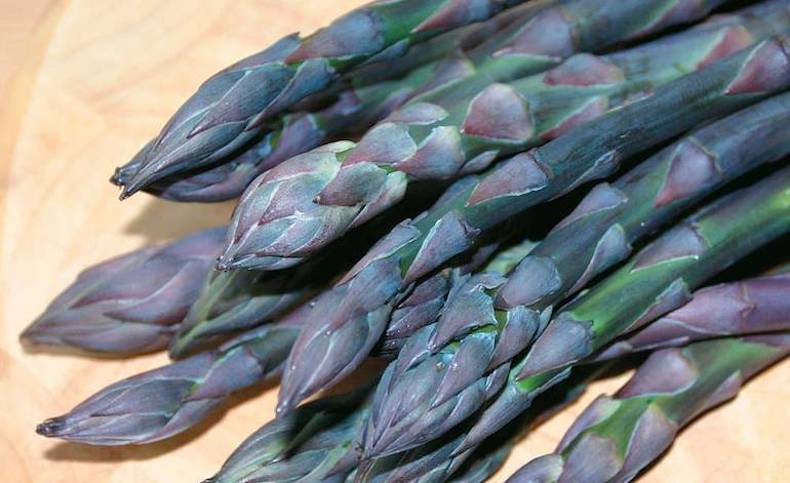
Steam these purple spears to retain their striking colour when cooked
Image: Asparagus officinalis 'Pacific Purple' from Thompson & Morgan
It takes a couple of years for new asparagus plants to be ready for harvest. Here’s your year-by-year guide to harvesting:
Year 1: Resist the temptation to harvest any asparagus spears during their first season. Instead, leave the plants to develop foliage - this will encourage stronger, healthier growth.
Year 2: You can harvest a limited crop of around half the spears in the second year of growth. Cut the spears when they reach around 6” tall. Alternately, leave them until next year when they’re better established.
Year 3: You can now harvest all spears for six weeks from mid-April onwards. Stop cutting at the end of May to avoid weakening the plant and to promote good cropping in the years to come.
Year 4 onwards: From now on, you can fully harvest your asparagus for eight weeks from mid-April each year.
Harvest each spear with a sharp knife when they’re around 15cm (6”) tall. Cut them at about 2cm below ground level. You can buy special asparagus knives to make this job easier but any sharp knife will do. The spears are fast growing, so you’ll need to check your crops every day during the harvest season.
Can you grow asparagus in containers?
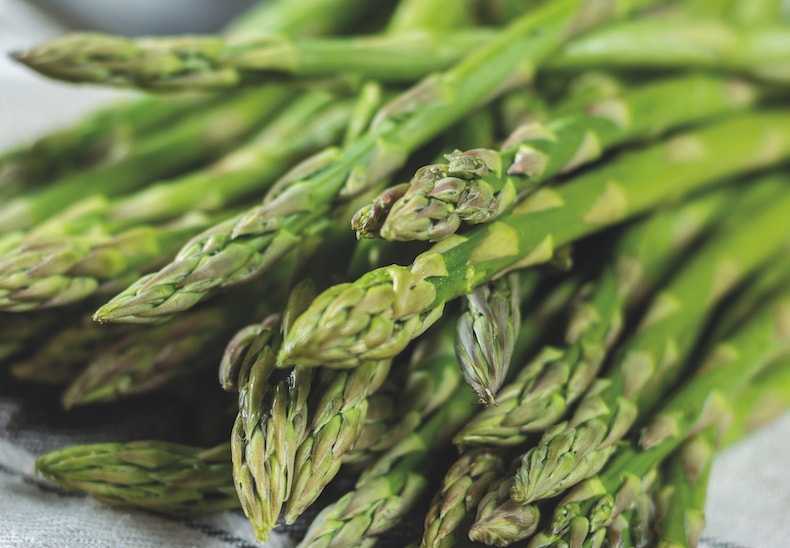
This 'all male' variety produces heavier yields than other varieties
Image: Asparagus 'Gijnlim' from Thompson & Morgan
It’s best to grow asparagus in the ground, but if necessary it can be grown in large pots or patio bags (at least 60ltrs) for a limited time. This is handy if you want to grow a crop on the patio or you can't justify giving your asparagus plants a permanent space in the vegetable plot.
But bear in mind, although asparagus grown in the ground will crop for up to 25 years, container asparagus has a much more limited lifespan - it will only crop for 3 or 4 seasons after the 2-year establishment period.
Which asparagus plants to grow?
Choosing the right type of asparagus can be daunting. Here’s a list of the most popular varieties to help you choose which type to grow:
| Asparagus Variety | Characteristics |
|---|---|
| 'Pacific 2000' | Fantastic flavour - voted the best variety in commercial grower taste-tests of 2006. |
| 'Burgudine' | Produces attractive, purple-tipped spears that can be eaten raw or lightly steamed. |
| 'Pacific Challenger' | One of the most disease-resistant varieties - tolerant to Phytophthora and Fusarium. |
| 'Guelph Millenium' | Particularly cold tolerant and well suited to UK weather conditions. |
| 'Pacific Purple' | Produces stringless purple spears that are more tender and sweet than many green varieties. |
| 'Vittorio' | Gives huge, top quality yields and can be 'earthed up' to produce tender white spears. |
| 'Mondeo' | Known for its impressive yields and quality, especially early in the season. |
Now you know how, where and when to grow asparagus as well as which varieties to choose. With a little effort, you’ll be reaping the benefits of your own asparagus crop for several decades to come. Learn more about growing asparagus including different planting techniques and variety advice over at our helpful hub page.
Sign Up For Exclusive Special Offers




© 2025 Thompson & Morgan. All rights reserved. A division of Branded Garden Products Limited.



